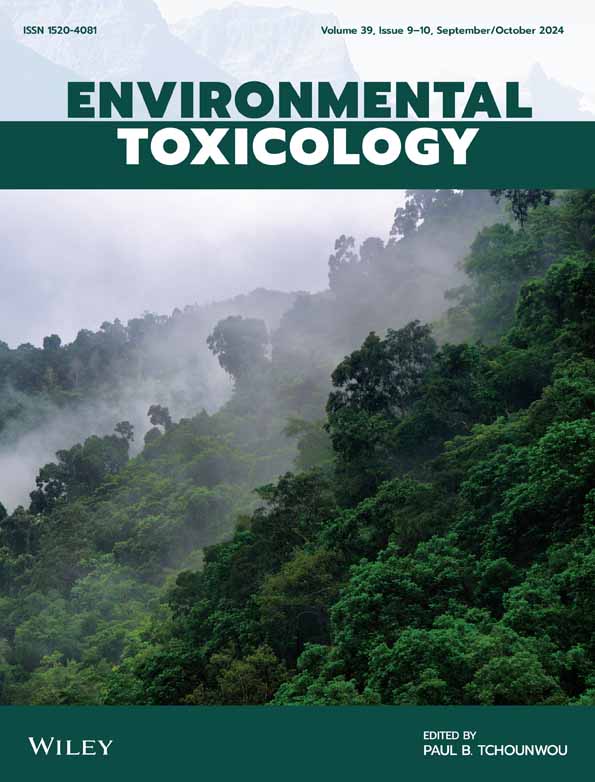以丹参为生物指示剂的丝光纤维素处理制革厂废水生态毒理学研究
IF 3.2
3区 医学
Q2 ENVIRONMENTAL SCIENCES
引用次数: 0
摘要
鉴于人们日益关注工业废水,特别是制革厂的工业废水对环境的影响,评估与这些废水有关的生态毒理学风险至关重要,即使是在进行补救处理之后。因此,我们旨在评估暴露于含有丝光微晶纤维素颗粒(MCPs)的原始和处理过的制革厂废水对耳木耳的潜在影响。本研究在评估对水生植物的残留影响的同时,解决了可持续处理替代方案的需求,可以降低毒性。植物在受控条件下暴露于污水稀释度(0.3%和3.1%)15天。分析了与生长、光合作用(叶绿素a、b和总)、氧化应激(ROS、MDA、亚硝酸盐)和抗氧化酶活性(SOD、CAT和SOD/CAT比值)相关的生物标志物。虽然MCPs降低了铬浓度,但处理后的出水仍然具有明显的毒性,根生长抑制达到40%,叶绿素a下降超过30%。主成分分析(PCA)和聚类分析显示,在Cr积累和关键生理生化指标变化的驱动下,群体分离明显。这些发现强调了mcp的部分有效性,以及在评估治疗技术时纳入生态毒理学终点的重要性。虽然MCPs代表了环境友好型修复的一个有希望的步骤,但需要进一步优化以减少残留毒性并评估长期和多物种效应。这项研究还加强了水生大型植物作为环境监测哨兵生物的效用,并支持制定结合化学和生物评价的更有力的废水管理战略。本文章由计算机程序翻译,如有差异,请以英文原文为准。
Ecotoxicology of Mercerized Cellulose–Treated Tannery Effluents Using Salvinia auriculata (Salviniaceae) as a Bioindicator
Given the growing concern over the environmental impacts of industrial effluents, particularly from tanneries, assessing the ecotoxicological risks associated with these effluents, even after remediation treatments, is crucial. Therefore, we aimed to evaluate the potential effects of exposure to raw and treated tannery effluents with mercerized microcrystalline cellulose particles (MCPs) on Salvinia auriculata a , b , and total), oxidative stress (ROS, MDA, nitrite), and antioxidant enzyme activities (SOD, CAT, and SOD/CAT ratio) were analyzed. Although MCPs reduced chromium concentrations, treated effluents still caused significant toxicity, with root growth inhibition reaching 40% and chlorophyll a decreasing by over 30%. Principal Component Analysis (PCA) and Cluster Analysis revealed clear group separation, driven by Cr accumulation and changes in key physiological and biochemical markers. These findings highlight the partial effectiveness of MCPs and the importance of including ecotoxicological endpoints when evaluating treatment technologies. Although MCPs represent a promising step toward environmentally friendly remediation, further optimization is needed to reduce residual toxicity and assess long‐term and multispecies effects. The study also reinforces the utility of aquatic macrophytes as sentinel organisms in environmental monitoring and supports the development of more robust effluent management strategies that integrate both chemical and biological evaluations.
求助全文
通过发布文献求助,成功后即可免费获取论文全文。
去求助
来源期刊

Environmental Toxicology
环境科学-毒理学
CiteScore
7.10
自引率
8.90%
发文量
261
审稿时长
4.5 months
期刊介绍:
The journal publishes in the areas of toxicity and toxicology of environmental pollutants in air, dust, sediment, soil and water, and natural toxins in the environment.Of particular interest are:
Toxic or biologically disruptive impacts of anthropogenic chemicals such as pharmaceuticals, industrial organics, agricultural chemicals, and by-products such as chlorinated compounds from water disinfection and waste incineration;
Natural toxins and their impacts;
Biotransformation and metabolism of toxigenic compounds, food chains for toxin accumulation or biodegradation;
Assays of toxicity, endocrine disruption, mutagenicity, carcinogenicity, ecosystem impact and health hazard;
Environmental and public health risk assessment, environmental guidelines, environmental policy for toxicants.
 求助内容:
求助内容: 应助结果提醒方式:
应助结果提醒方式:


